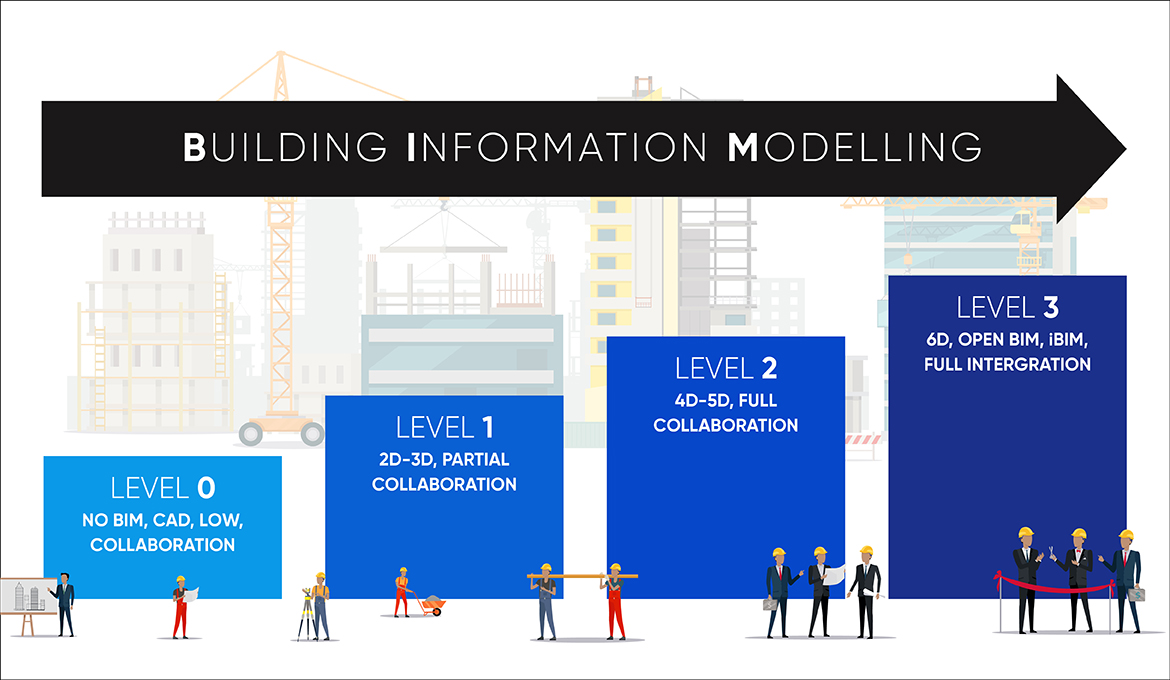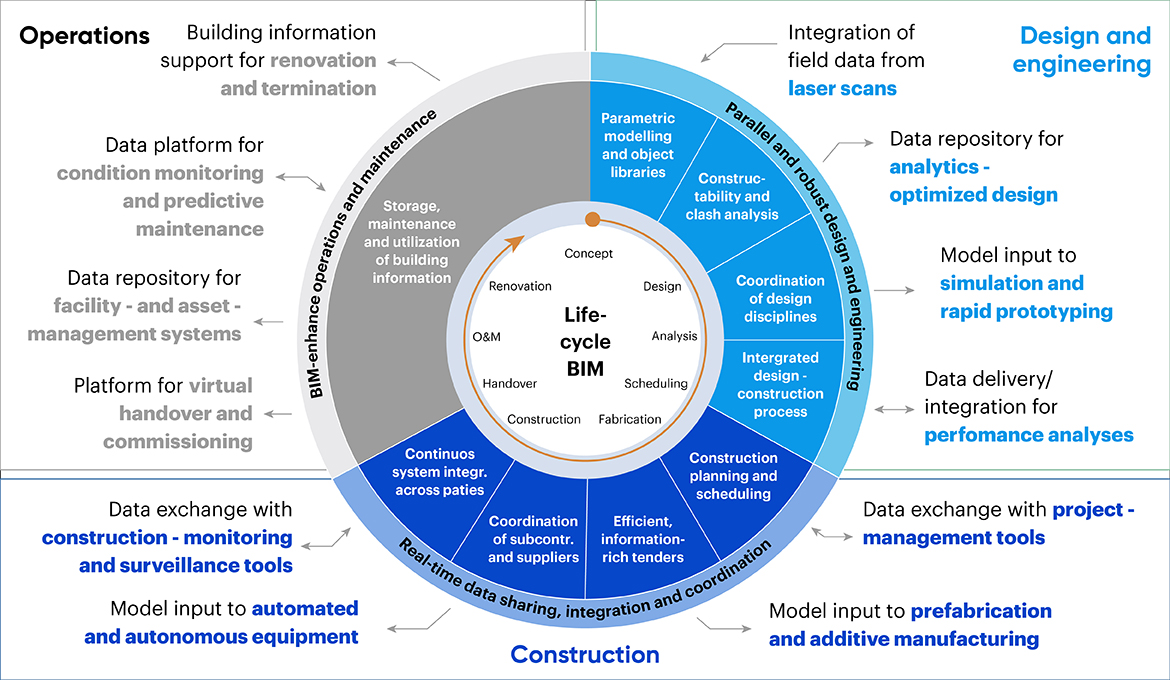BIM technology aims to express all physical objects in a building including the physical, technical and commercial characteristics of the object. This technology makes it possible for real estate companies to quickly assess transportation times, construction times, lifecycle costs, other important variables, etc. and brings new value to the building throughout its life cycle.
BIM creates comprehensive value
BIM is the process of creating and managing digital information throughout the life cycle of a construction project. BIM represents a numerical description of all aspects of the property being built. This information is detailed throughout the design, construction, and operation stages.
In terms of BIM semantics (Building Information Modeling) means “information model of construction”, Consisting of 2 types of geometric information (long, wide, tall sizes, distances between building components such as beams, columns, floors, doors, stairs, roof, etc.) and non-geometric information (information about product characteristics, specifications, such as which supplier Lavabo sink, how the model is, how much; steel mass, material, intensity,… to estimate the price,…).
BIM enables interaction throughout the entire supply chain to optimize actions at each level, thereby creating superior comprehensive value for assets. The following figure shows the level of evolution and the general value that BIM brings:

4 Levels of Evolution of BIM Technology
- Level 0: Construction works that do not use any digital models, for example, have not used CAD software, then the level of collaboration in work from design, construction and transportation is very low (low collaboration)
- Level 1: Digital tools that can model geometric information (2D, 3D – length, width, high) will increase the level of partial collaboration, for example, based on a 3D model design department engineers will easily discuss the optimal solution.
- Level 2: Digital tools in addition to geometric information modelling (2D, 3D) also add 4D non-geometric information (integrating additional elements of time and progress of the building) or 5D (BIM 5D integrates additional factors of cost and cost). Geometric information, plus information related to time, progress and cost information will allow all relevant departments to easily collaborate comprehensively, in addition to the information obtained also helps management levels conveniently manage the overall project, project management, cost management, construction management, quality management, risk management,…
- Level 3: This is an upgrade of the BIM 5D model, further controlling the energy element inside and outside the building into 6D, for example, the engineer designed the application to control the energy, temperature, lighting indicators of the building. In addition, more information about the equipment used in the project with high detail used in maintenance during the operation of the project. When evolving to level 3, Open BIM technology will allow full integration with other information that helps the modelling of information not only within the scope of construction but to other areas such as energy, detailed information of equipment to be maintained,…
BIM’s new values across the construction value chain
BIM technology brings breakthrough values throughout the construction industry’s value chain from design to construction and operation. The following model demonstrates the new values brought by BIM technology to the construction industry:

With all stages including design and engineering, construction, operations, BIM will lead to different new values.
The design phase
During this period, engineers and technicians often do concept, design, and analysis. BIM technology can increase productivity with tools and information to help carry out parallel, efficient and intuitive operations. There are accessible directions that bring value such as Building parameter models and libraries of physical objects by integrating information from the field.
- Building capability analysis and conflict detection (There is a conflict of location between two elements in the construction phase of a project that can be costly and time-consuming)
- Create fast realistic prototypes
- Construction process – integrated design
Construction phase
Things to be done such as planning, bidding, construction and handover. BIM technology enables the sharing, integration and coordination of data in real-time to bring a lot of value to operations during this period such as:
- Easy, reasonable, effective construction planning. Get a lot of information to help to bid effectively
- Easy to coordinate with subcontractors and suppliers
- Integrating and exchanging data with tools to monitor and monitor construction,…
Operation phase
Things to be done such as operation, maintenance and renovation. BIM technology will store, maintain and use building information including a wide range of data types: infrastructure information, assets, management,… The exploitation of this data will help the process of operation, maintenance and renovation through:
- Monitoring the condition, predicting maintenance (performing maintenance in the right place, at the right time) to improve the life of the building
- Determine the renovation of the building quickly, in the right scope
The values of BIM bring through the stream of the process of creating construction products that bring great benefits. In a Stanford University report based on 32 BIM-based projects, there are many benefits such as a 40% reduction in change requirements; The deviation of the settlement with the estimate is only +/- 3%; 80% reduction in estimated time; Cost savings of up to 10%; 7% reduction in progress (3),…
The opportunity in Vietnam
On December 22, 2016, Deputy Prime Minister Trinh Dinh Dung signed Decision No. 2500/QD-TTg, approving the BIM application scheme for construction and operation management. The goal is to save at least 30% on aggregate conversion costs from related entities implementing BIM, enhancing transparency and convenience in management, quality control of construction activities and management of construction operations. The project has been officially approved and the implementation roadmap in January 2017 includes the following specific stages:
- From 2017 to 2019: Preparing the necessary conditions and skills training for the adoption of BIM
- From 2018 to 2020: Pilot implementation in some construction
- From 2021: Based on summary and evaluation of BIM application, the Ministry of Construction promulgates a Circular and specific guidance for widespread application of BIM in construction activities and management of the operation
Through the implementation process in the period from 2018 to 2020, there have been several pilot projects applying the Building Information Model (BIM) in construction activities and operation management such as “the working headquarters of the Government and the Government Office”, “Headquarters of Military Industry and Telecommunications Group”, “Investment project to build Cua Dai Bridge, Quang Ngai Province”, “Phu Bai International Airport Passenger Terminal”, “Central Geriatric Hospital Facility 2, Ho Chi Minh City”,…
Typically, the project “Headquarters of Military Industry – Telecommunication Group” has applied BIM for all three stages. The BIM application design phase aims to review the design, coordinate 3D design, conflict management, publish detailed drawings of construction after coordination. The construction phase of the BIM application collects asset and space information according to COBIE (International standards for asset information management) which makes it easy to integrate into software such as planning, construction management to monitor supervision, construction,… BIM application operation phase aims to manage facilities through updating, receiving operation management data, encrypting assets using QR codes,… that help to actively manage the operation and maintenance of equipment.
Many pilot construction has been completed, and the Government has initially introduced policies, technical standards, economic norms,… create an important legal corridor to encourage the widespread adoption of BIM technology.
BIM technology creates new value that brings benefits throughout the series of construction creations from design, construction to operation. New policies and standards have been introduced, are part of the national strategy and there are many pioneering constructions implemented in practice. Real estate companies can follow this new wave to bring new value and cost savings from BIM. However, requiring businesses to train staff who are ready to receive and raise awareness related to the strategic vision of the leadership team is a necessary condition to make the most of the BIM value.
Reference sources:
(1) Research Gate
(2) Chinh Phu
(3) Stanford
(4) PBC Today
(5) Công nghiệp Công nghệ cao



